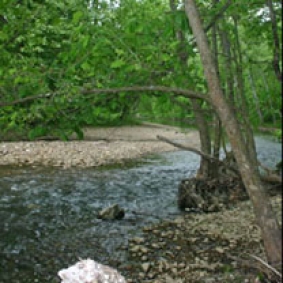Knauss legislative fellowships in Congress help build careers — and they're fun and educational. See our video and fact sheet for details.
Accurate Maps Needed to Protect Streams in the Headwaters of the Chesapeake

In many rural and suburban areas, small streams weave through patches of forest and farmland. Often overlooked by the untrained eye, these water bodies carry with them the beginnings of fragile, yet very important ecosystem processes -- clean drinking water, habitat for aquatic life, and rapid processing of nutrients.
But increasing urbanization in near-coastal areas puts these delicate environments in jeopardy, explain Andrew Elmore and Sujay Kaushal, researchers who are working to characterize the essential nature of these channels. Elmore is at the University of Maryland Center for Environmental Science’s Appalachian Laboratory and Kaushal is at the Department of Geology at the University of Maryland, College Park.
With development, streams are paved over or diverted underground by culverts and stormwater drains. These processes not only inhibit all of the important ecosystem services that headwater streams provide, but can further impair water quality as it is transported downstream into the watershed.
Burying streams amplifies the ecological impacts of natural erosion processes, says Kaushal. “Nitrogen, road salts, metals, and organic contaminants are funneled from the landscape into larger streams from these buried streams,” he says. “Buried streams increase interconnectivity between the watershed, impervious surfaces, and other streams.”
Headwater streams, in particular, are extremely valuable in their ability to remove or reduce nitrogen pollution at an early stage through denitrification -- the process of bacteria taking up nitrates and converting it into gas. Introduction of pollutants and loss of natural aquatic environment by stream burial could degrade the larger water bodies fed by these headwater streams. If the water is contaminated at the uppermost points of the watershed, conditions may grow worse downstream.
With funding from Maryland Sea Grant, Elmore and Kaushal are working to map headwater streams and buried streams in the Gunpowder-Patapsco watershed in Baltimore County. One discovery they’ve made is that many headwater streams are not protected from burial simply because what defines stream is still up for debate. They found that streams with a catchment area (or area of land drained by a body of water) of less than one square mile were not being actively preserved or even treated as legitimate streams.
“These are fairly large streams that are not being conserved,” says Elmore. “Landscape as a whole is 75% buried by pavement in Baltimore City. The only headwater streams left are the ones in state parks.”
Before the study began the locations of many headwater streams were largely unknown. Mapping methods had been developed for outlining the locations of headwater streams but never on such a large scale.
Andrew Elmore and his colleagues mapped headwater streams throughout the watershed by following the channels upstream to their highest elevation. Pinpointing stream location proves more difficult in the absence of water, Elmore explains. In these cases, Elmore looked for stream channels with so-called bedload -- gravel, sand, and rocks left after soil washes by flowing currents. Elmore and his team compared landscape metrics and other stream characteristics in an attempt to develop a mapping system that incorporates the topographical variability of watersheds across Maryland. These maps should allow them to predict where other streams may exist based on those conditions.
Mapping the watershed is just the beginning, say the researchers. They hope that it will eventually lead to protecting and restoring streams. “Just knowing the extent of some of these natural headwater areas will be critical for protection,” says Kaushal. “If you don’t know the extent to which they exist, how can you set policies to protect them?”
-- Matt Ellis
Learn more: See Maryland Sea Grant's page about watershed restoration.





